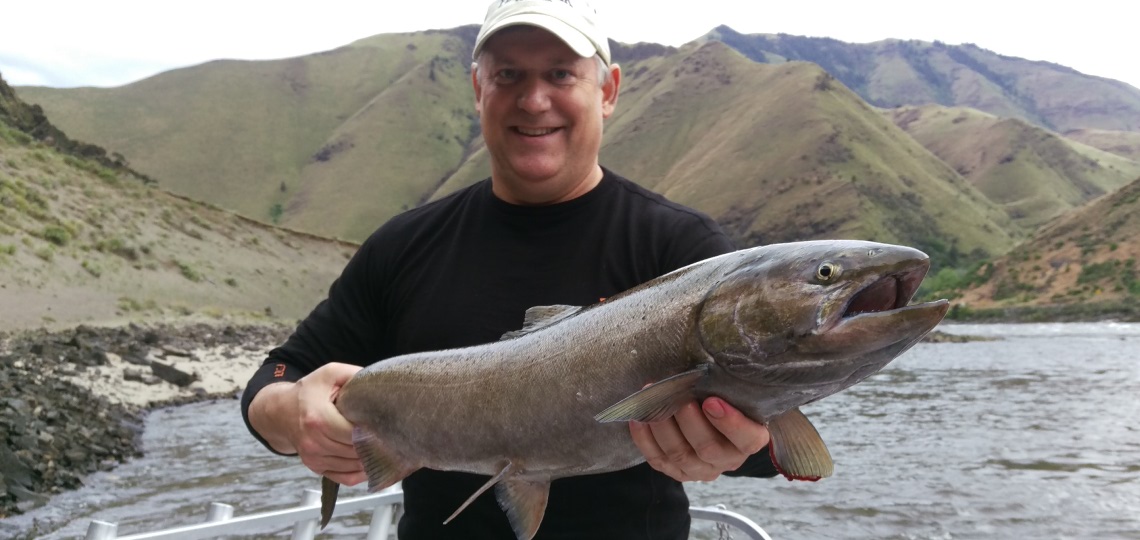
Key Salmon Populations Cross Alarming Threshold — and More Are Nearing That Line
Eric Barker / Yahoo! News
(May 5, 2021) — Nearly half of the wild spring chinook populations in the Snake River Basin have crossed a critical threshold, signaling they are nearing extinction and without intervention may not persist, according to analysis by the Nez Perce Tribe.
The river’s steelhead populations, while doing better, also face alarming threats to their existence, according to the work.
Modeling conducted by fisheries scientists at the tribe, and shared with other state, federal and tribal fisheries managers in the Columbia Basin, indicates if current trends continue, 77% of Snake River spring chinook populations and 44% of steelhead populations will be in a similar position within four years.
Tribal fisheries officials say a wide array of short- and long-term actions, such as new conservation hatcheries, predator control, increased spill at Snake and Columbia river dams, and adoption of Rep. Mike Simpson’s plan to breach the four Lower Snake River dams, are urgently needed.
Fisheries officials in Oregon and Washington agree dam removal should be considered and other actions above and beyond current salmon and steelhead recovery efforts should be pursued.
The tribe found 42% of Snake River spring chinook and 19% of steelhead have reached the quasi-extinction threshold — an analytical tool used by the federal government to assess the risk of extinction or measure the viability of fish populations. The threshold is tripped when a natural origin population of fish has 50 or fewer spawners return to natal streams for four consecutive years.
“It’s a return, a series of returns, that demonstrates you better do something or you are going to lose your ability to do much of anything,” said David Johnson, director of the Nez Perce Tribe’s Department of Fisheries Resources Management.
Further modeling by the tribe shows Snake River spring chinook populations that are protected as threatened under the Endangered Species Act declined at a rate of 19% over the past 10 years and steelhead fell at an 18% clip during the same time period.
Jay Hesse, director of biological services for Nez Perce Tribal Fisheries, examined data from 31 of the basin’s 32 native spring chinook populations that return to places like the Middle Fork of the Salmon River, Loon Creek, the Grande Ronde River and the Imnaha River. Of those, 13 already meet the threshold and more will soon follow, according to the analysis.
“If you take that 19% rate of decline and say going forward, where does that put us, and project out for five years, you end up with 24 of the 31 populations being below 50 natural origin spawners by 2025,” he said.
Hesse analyzed 16 of the basin’s wild steelhead populations. The sea-run rainbow trout also listed as threatened under the ESA are doing better than chinook, but have declined rapidly during the past five years or so because of poor ocean conditions. The fish have posted a 10-year downward trend of 18%, nearly identical to the nosedive by spring and summer chinook.
That trend projected forward puts seven of the 16 native steelhead populations analyzed by the tribe, or 44%, below the quasi-extinction threshold by 2025. The slide for the big B-run steelhead cherished by anglers is steeper — more like 23%.
“Look at the population names at the very bottom,” Hesse said, pointing to a graph charting the projected decline of steelhead. “The South Fork Salmon, South Fork Clearwater, Lolo Creek, Secesh River — those are all populations that are the B-run life history.”
Representatives from other agencies that manage salmon and steelhead in the basin praised the tribe’s work and said it signals the need for more conservation measures.
“If this isn’t a wake-up call, I’m not sure what folks would be looking for,” said Tucker Jones, ocean and salmon program manager for the Oregon Department of Fish and Wildlife.
“We think their analysis is cause for concern,” said Bill Tweit, special assistant in the Washington Department of Fish and Wildlife’s Fish Program.
“Anytime you have a total spawner abundance less than 50 fish, that really puts you in a bad spot,” said Lance Hebdon, anadromous fish manager for the Idaho Department of Fish and Game.

The National Marine Fisheries Service, also known as NOAA Fisheries, is in the midst of five-year, Endangered Species Act-mandated status reviews for spring chinook and steelhead. Chris Jordan, a scientist with the agency’s Northwest Fisheries Science Center, said the tribe’s work largely mirrors a viability assessment his shop is working on. While it’s not uncommon for populations to fluctuate, he said the latest downturn is worrying.
“What becomes more and more concerning as time goes on is if these populations don’t rebound from changes in the ocean.”
Michael Tehan, assistant regional administrator for NOAA Fisheries, said while the data is concerning, the fish have displayed remarkable ability to bounce back from previous low abundance. He also said the agency is looking for additional measures to help the fish.
Earlier this year, scientists with the agency’s Northwest Fisheries Science Center published a paper projecting that climate change could cause already low survival rates for Snake River spring chinook to plummet by 90% and the fish could face extinction by 2060. The study, led by Lisa Crozier, said urgent actions are needed to counteract the fish-killing effects of warming oceans and reduced river flows brought on by climate change.
The tribe’s analysis included a chart of the downward trend predicted by the federal scientists with the addition of actual spring chinook returns from 2019 for reference.
“So as grim as her (Crozier’s) projections look, we are saying we are already starting that decline and we are already there at the quasi-extinction threshold,” Hesse said. “I think it adds urgency that this is going to continue.”
Posted in accordance with Title 17, Section 107, US Code, for noncommercial, educational purposes.